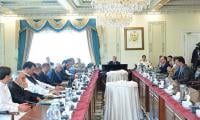The PML-N’s intended policy of privatising a number of state-owned enterprises has generated a lively debate among the proponents and opponents of this move.
The proponents are generally those who believe in the power of markets to distribute just rewards to the factors of production in a laissez-faire economy without state interference. Meanwhile, the objections raised by the opponents mainly focus on the distributional, welfare and wealth concentration concerns that result from the sale of public assets. In short, they favour the active role of the government in managing the country’s economic affairs. And the magnitude and nature of a government’s role in economic activities is at the heart of this debate.
As far as the industrialised nations are concerned, the recession that befell their economies in 2008 has seen an increasing role for the state in economic affairs. It either takes the form of direct interference or providing assistance to the private sector. This is especially pronounced in the US.
Once believed to be a bastion of laissez-faire capitalism, its economy is now witnessing extensive involvement from the government in the form of fiscal stimulus and a loose monetary policy. Both these strategies are aimed at averting the further downslide of an already sluggish economy.
This is a far cry from the laissez-faire practices of the Margaret Thatcher and Ronald Reagan eras, which came to dominate Western economic philosophy till the end of the 20th century.
Until the early 2000s, there was little, if any, challenge to this free market ideology that was propagated and championed by economists like Milton Friedman. But beginning with the dotcom bubble, state involvement gradually grew again. The relative success of the Scandinavian welfare economies, the Chinese model of state-controlled capitalism and sovereign wealth funds (owned by various governments) complemented this trend. In all these cases, the common theme is the control and regulation of economic resources by the governments.
As far as the present debate over privatising public assets in Pakistan is concerned, the case would seem to tilt heavily in favour of privatisation. Public-sector entities (PSEs) like Pakistan Steel Mill and PIA cost the nation and its taxpayers a whopping sum (in excess of Rs500 billion or more per year). The irony is that all the money pumped into these institutions seems to have little effect on their performance as they have continued to spiral downwards. Moreover, in a situation where the government seems hard-pressed for resources to run the day-to-day affairs of this country, obtaining extra cash through sales could come in handy.
However, the ground reality is that not many people are willing to dole out cash for loss-making enterprises like PIA and Pakistan Steel. It would be pertinent to mention here that whatever privatisation has taken place, it has been in the form of selling profitable enterprises rather than loss-making ones. Given the above, the case in favour of the privatisation of public assets would seem straightforward. In our case, though, there are some caveats. For one thing, the PML-N’s past record and its recent performance do not invoke much confidence.
Russia’s example should serve as an eye-opener in this regard. In the wake of the USSR’s dismemberment, public assets were sold to the then president’s favourites at throwaway prices. The whole process ended up in the formation of oligarchies that still dominate the Russian economic landscape, with the Russian economy being marred by highly unequal wealth distribution. Any observer of Pakistan’s economic affairs would immediately recognise the presence of cartels and oligarchies in Pakistan’s economy (and the influence they exert on our economic affairs). Moreover, the failure to appoint qualified, competent individuals to head important state institutions does not elicit much confidence in the PML-N.
This brings us to the all-important role of the government in economic affairs. Historically, the government’s dominant role in our economy made sense. At the time of Pakistan’s creation, there was little alternative but for the state to directly taking economic management into its own hands as the presence of the private sector was rather limited. But now, there seems little logic in the state directly running factories and mills – a task at which it has performed quite poorly. The failure to properly manage these entities has been complemented by policy disasters such as the nationalisation policies that were adopted and the illogical, state-led subsidies that keep this national burden intact.
The case for the sale of PSEs that are incurring heavy losses seems to be the correct approach as far as Pakistan is concerned. There are not many people who will argue against this point. But the past performance and the present decisions of this dispensation have given rise to many questions that remain unanswered. For example, what is the guarantee that a state machinery which is addicted to overspending will be more wise and prudent in the future when it comes to the use of public resources? Where will the money from the sale of these assets be spent? After all, the PML-N government paid billions of rupees in lieu of circular debt when it came into power – which turned out to be another controversial, non-transparent transaction. But by now, it’s back to square one again. To put it simply, merely spending money does not guarantee economic efficiency and improvement.
So what should the Pakistani state do? A post-recession example from the US presents a good model for efficient economic governance. In the wake of the recession of 2008, AIG, which is one of the largest insurance group in the world, was on the verge of collapse. The US government stepped in to provide an easy installment loan of $85 billion in order to avert the financial bankruptcy. The main driver of this decision was to prevent the social ramifications that would result if thousands of jobs were lost in case AIG collapsed. As a result of the financial help, bankruptcy was avoided and the jobs remained intact. Within a few years, AIG returned the loan.
The US government did not overtake AIG or place a serving (or retired) babu to run the organisation. Instead, it extended its help to AIG so as to ensure that it remained intact. The same help was extended economy-wise in one form or another. This example should ideally be followed in Pakistan, where government-led economic management has proved to be nothing but a disaster. In short, it should be about supporting the economy and businesses rather than running it.
It should be noted that the sale of public assets will not signal an end to the government’s involvement in economic affairs. State involvement in the economy has always been the case and it will remain so, even though the magnitude of its involvement has differed over time. Unlike private firms that can liquidate and vanish due to their poor performance, governments have obligations that they have to fulfil regardless of whether they are performing poorly or not. The critical factor in this regard revolves around the government making effective use of resources that are at its disposal. In Pakistan, that smartness has proved elusive till now.
The writer is a freelance contributor.
Email: shahid.mohmand@gmail.com
Twitter: @ShahidMohmand79
People stand in line up as election officials check their ballot papers during voting general election at a polling...
Women show their voter identity cards as they stand in a queue before casting their votes in Agartala. — PTIThe 18th...
Former prime minister Imran Khan. — Instagram/ imrankhan.ptiAn old saying has it that “when you dance with the...
Kashmiris in Indian illegally occupied Kashmir protesting against the Indian occupation as the forces of India looked...
A representational image showing residents walking at a wholesale market in Karachi. — AFP/FileOnce again there is...
A representational image showing late Pakistani human rights activist and Supreme Court lawyer Asma Jahangir. —...







